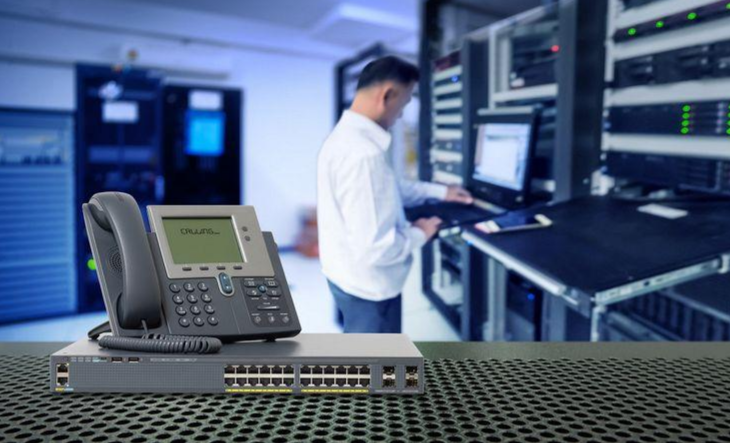Setting up IP telephony in the office - step-by-step instructions
Setting up IP telephony in the office
Despite the development of chatbots, the active implementation of special forms of communication in online stores and other sites that allow the client to place an order and get answers to various questions without interacting with an operator, most customers prefer talking to “live” consultants.
In order to prevent potential clients from leaving for competitors, not to lose income, and to strengthen their reputation, an organization should think about implementing IP telephony in the office. Effective use of this system, of course, will be possible only if it is properly configured. How to do this?
Concept
IP telephony is a technology that allows you to make voice calls over Internet protocols. It is based on the principle of two-way conversion: the analog voice signal is transformed into a digital signal, and on the receiving subscriber's device - vice versa.
This method of communication removes geographical restrictions. It is not supposed to be tied to a landline device, you can use telephony from anywhere, a smartphone connected to the Internet with a special program is enough. Of course, the system can also be built on the basis of other hardware components, both specialized IP phones and universal ones, computers, laptops. All these points must be taken into account when setting up.
Advantages
The value of Internet telephony for an office, commercial structure or other enterprise whose activities are aimed at making a profit is due to its following advantages:
- Minimum cost of calls. In most cases, they are free, in some cases - orders of magnitude lower than when using standard telephone lines.
- Mobility. Employees can use telephony not only directly at their workplace, in the office, but also on the road. The main condition is stable Internet access. Mobility is a quality that greatly simplifies the relocation of an organization. There is no need to re-form a client base, incur significant financial losses, notify regular customers and partners about changing numbers, since they remain the same.
- Advanced capabilities. Internet telephony supports many functions useful for business. For example, if there are no free operators, the caller will be transferred to a voice assistant. Automatic addition of new client data to CRM is also available, as well as display of caller information so that the operator immediately knows who he is dealing with, and understands the needs and status of the interlocutor without unnecessary words and explanations.
IP telephony schemes
The specifics of setting up Internet telephony are determined by its scheme and structural features. Several options are available, which allows you to choose a solution that 100% corresponds to the scale of a commercial enterprise, the specifics of its activities, the services provided, and the client base. Each of the schemes should be considered in more detail.
Computer-to-computer
In this case, the connection is established between a PC, two, or laptops. This can be done provided that there is stable network access, a headset connected to the computer, and an installed program, a softphone, allowing you to make and receive voice calls, video calls, and send multimedia files.
It is the software that performs the main tasks, processes and transmits information. If necessary, you can also contact other subscriber devices from the computer, such as smartphones.

Computer-phone
One of the most common schemes. It is not surprising, because most clients prefer to contact operators using smartphones. The communication algorithm is as follows:
- A call is received from a PC to the SIP server of an organization providing IP telephony services.
- Call forwarding to the telephone operator's network.
- Call routing, transfer to the subscriber served by the operator who received the call, or to another organization, local, regional or foreign - depending on the number.
If the call is initiated from a smartphone, the reverse algorithm takes place.
Phone-phone
Office operators use IP and standard phones connected to gateways, which allows them to make calls to both mobile and landline city numbers. The best option for using such a system is to use virtual telephony, which allows you to call not only neighboring cities, regions, but also countries with minimal charges. The quality of communication is at the highest possible level, there are no delays or other problems.
PBX: office or virtual?
The specifics of setting up IP telephony are determined by the features of the PBX. The standard option is office stations, presented in analog, digital and combined modifications, as well as a server, the tasks of which are assigned to a computer or laptop.
The principle of operation of the PBX depends on its characteristics. For example, in digital models, a preliminary transformation of the analog signal into a digital one occurs, in hybrid models, this is not required, which ensures versatility, ease of switching with any telephone sets, analog and system.
The main points to consider when setting up an office PBX are as follows:
- Availability of free FXO ports for connection. After switching, you need to specify the necessary routing for correct call distribution.
- Installation of suitable software. Free programs will be enough for small offices, but large organizations should pay attention to paid editions with advanced functionality, support for multi-channel numbers, and the ability to connect call forwarding.
- Competent assignment of numbers. This is necessary for the accuracy and efficiency of redirection.
Virtual PBX
Virtual PBX is a more convenient option for connecting IP telephony in the office. The company does not have to spend money on equipment, waste time, servers are provided and maintained by providers. The only thing you need is phones, which can be either softphones, programs installed on a PC, or specialized IP devices.
The scheme assumes that all calls are received by a cloud server, which distributes them to subscriber devices. The subtleties of the settings are determined by the capabilities provided by the provider. For example, with the support of a virtual PBX API interface, synchronization with CRM and other applications, systems required by the organization is possible. In addition to multifunctionality, the following advantages of virtual PBX should be noted:
- Support for multichannel, federal and other numbers, memorable, increasing the level of customer trust.
- A variety of tariff plans offered by providers, which allows each company to choose an option that is balanced in price and range of services.
- Ease of maintenance. Setup, like other service operations, is the provider's area of responsibility, so the organization will not have to keep highly paid administrators and other specialists on staff, loading the payroll.

Implementation and configuration algorithm
When connecting Internet telephony in a commercial organization, office, you need to adhere to the following algorithm:
- Internet connection, conclusion of a contract for communication services. At the same time, the access speed should correspond to the actual needs, the scale of the enterprise. A small company will be satisfied with a fairly modest tariff plan, a large one - a dedicated fiber-optic line is recommended.
- Installation of an office PBX or conclusion of an agreement with a company providing virtual telephone exchange services. The second option is more preferable, the main thing is to choose the right provider, guided by its reputation, status, as well as the tariff plan - taking into account the available budget, planned expenses, the number of operators using IP telephony.
- Selection and purchase of equipment. The kit is determined by the PBX format. When using an office system, you will have to spend a lot of money on hardware, while with a virtual system, you can limit yourself to softphones, which significantly reduces costs.
- Final setup, connecting additional functions necessary for the efficient operation of the organization. There are many options in this case: synchronization with CRM, using voice assistants, automating call recording, or even implementing artificial intelligence systems that will analyze calls, determine the qualifications of operators, and detect errors. Neural networks are developing at an active pace, so that year after year they can be assigned more and more tasks, freeing operators from the need to perform routine actions, using their competencies more effectively.

Summing up
The advantages of IP telephony in the office are obvious for any organization, regardless of the scale of activity, be it a small commercial firm or a large enterprise whose client base is measured in tens of thousands of people. The SIP protocol will help to use this technology not only for voice calls, but also for transmitting multimedia files, photos, images, videos.
Comparison of the format with classic analog telephony shows the following advantages:
- Minimum cost of calls;
- Not tied to specific stationary equipment;
- Easy setup and installation;
- Variety of options, abundance of auxiliary functions.
The most rational option for implementing Internet telephony is a cloud, virtual PBX. This approach simplifies setup and maintenance, saves enterprise resources, while eliminating any problems associated with functionality, reliability, and quality of communication.
Answers to popular questions
How soon can I start using the service?
The user account is opened immediately after the application is submitted.
Immediately after making the payment, you can start using the service immediately.